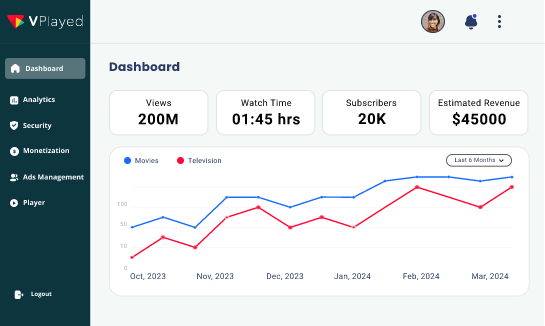Stream & Earn Revenue From Your Video Content With 10+ monetization Models & 1000+ Features.
Request a Free DemoServer-Side Vs Client-Side Ad Insertion: What’s The Difference?
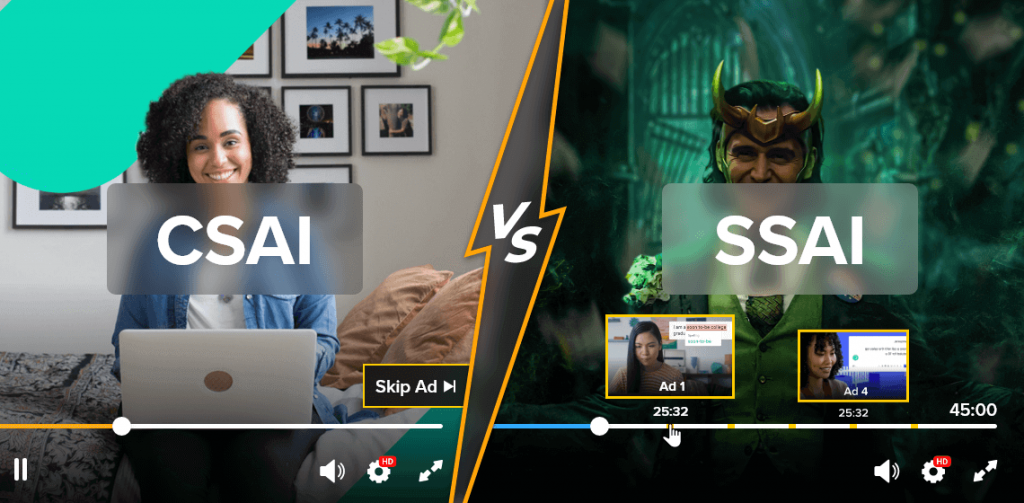
Ad personalization stands as the most popular method for content aggregators to maximize revenue through their content and drive growth via online video monetization platform. The primary objective is to pave the way for substantial increases in the subscriber base.
Ads play a pivotal role in achieving this goal by strategically incorporating them into videos – either through CSAI, commonly known as client-side ad insertion, or SSAI, denoted as server-side ad insertion.
Moreover, there are abundant opportunities in ad personalization as it enables connecting with individual viewers in numerous ways. Audiences can freely consume content, either by accessing it for free or by opting to watch ads instead of paying or subscribing to the service.
For businesses looking to create a video streaming website like netflix, implementing effective ad personalization strategies can significantly enhance viewer engagement and maximize monetization potential.
Having said that, the growth of ad insertion poses challenges for a number of broadcasters, pay-TV operators, content programmers, and various video providers striving to meet the diverse needs of their businesses and target audiences.
With this being clear, let us look into the criteria differentiating SSAI vs CSAI in this article.
Table of Contents
What is CSAI?
CSAI, or Client-Side Ad Insertion, is the method employed for delivering ads to devices such as desktops, mobiles, CTVs, and gaming consoles. In this approach, the html5 video player requests the ad server to stream an advertisement when it reaches specific ad markers in the stream or, technically known, in the manifest file (HLS/DASH).
Upon receiving the request from the player/device, the ad server strategically responds with the appropriate ad based on data collected from various sources, including campaigns and audience preferences.
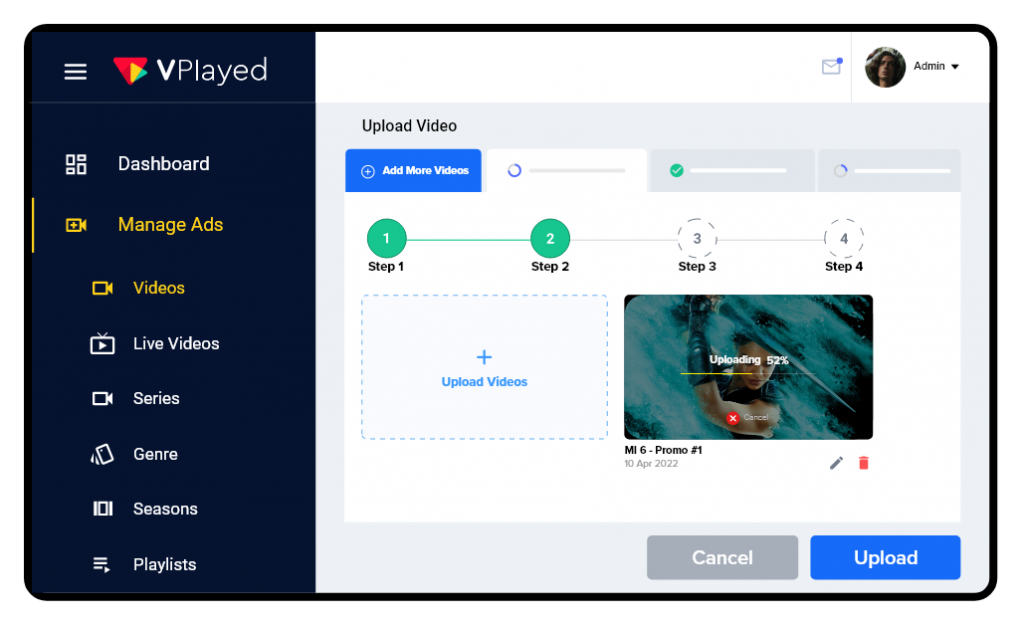
CSAI functions by having the video player pause the content, and in this interim, the ad is played. Subsequently, the content or video playback resumes. In this process, the client assumes a major responsibility for reporting on the ad performance through various metrics and dimensions.
It can support skippable, clickable, and closable ads, along with providing rich tracking and metrics for ad performance reporting. Notably, CSAI can be deployed without ad marketers. This dynamic approach allows for a comprehensive understanding of ad performance and enhances the overall effectiveness of client-side ad insertion.
Some of the metrics and dimensions include:
- VAST (ad metadata)
- VMAP (ad timing)
- VPAID/SIMID (interactive ads)
- OMID (viewability measurements)
Looking To Build Your Own Video Monetization Platform?
Start and Grow Your Video Streaming Service With 1000+ Features & 10+ Revenue Models.
 Highly Customizable
Highly Customizable Life Time Ownership
Life Time Ownership Own 100% of Your Revenue
Own 100% of Your Revenue
 Full-Branding Freedom
Full-Branding Freedom

How Does Client-Side Ad Insertion Work?
In this section, let us look into the processes of how CSAI (Client-Side Ad Insertion) operates.
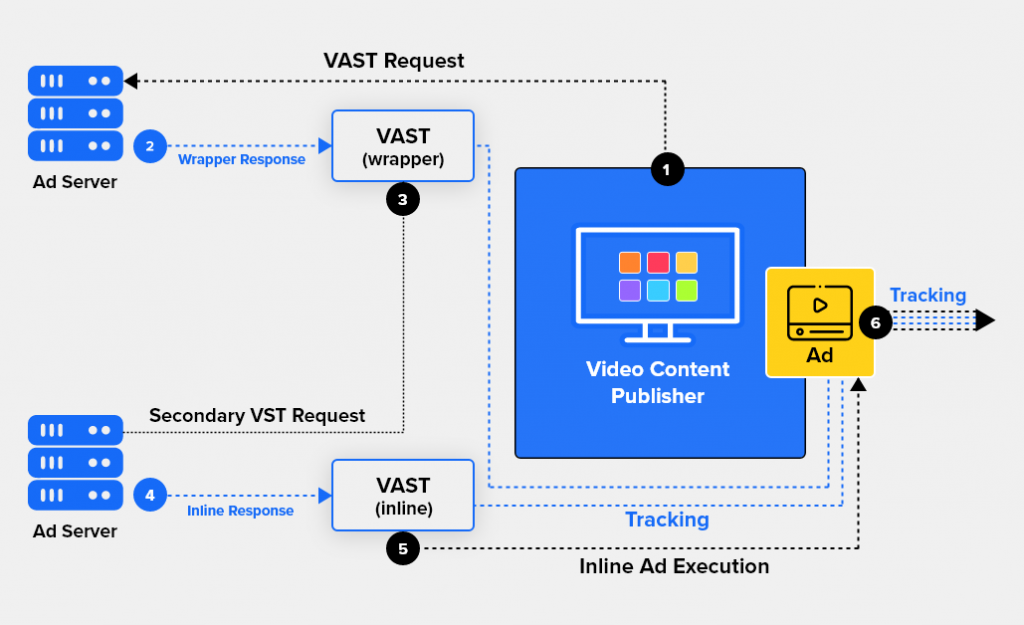
- At the onset, the player downloads the file from the CDN before video playback commences. For example, in a pre-roll ad scenario, the ad initiates before the video content begins.
- When the video player reaches an ad marker, it initiates an API call to the ad server, requesting an ad for playback.
- Typically, the ad insertion server responds with a VAST XML that includes data about the ad, the ad’s media, and tracking information.
- The video player uses the VAST tag to initiate and execute the ad playback, thereby ensuring seamless integration within the content flow.
- Upon the conclusion of the ad, the video player resumes the video stream, maintaining a smooth transition for the viewer.
- Streaming platforms commonly integrate their video players with SDK support offered by third-party ad services.
- SDKs actively monitor the position of the ad playback, completion rates, errors, etc., and recurrently report this data back to servers, ensuring complete tracking and analytics.
What is SSAI?
SSAI, commonly referred to as server-side ad insertion, represents a video ad-serving method wherein ads are seamlessly stitched directly into the video streaming content on the server side, as opposed to within the client application or video player. This method stands in stark contrast to the workings of CSAI.

Now, let us explore the merits and demerits of SSAI in the sections that follow. One key advantage lies in the fact that the client no longer initiates server calls, highlighting the challenge of blocking ads inserted using SSAI.
Adding to its prowess, SSAI’s functionality comes to the forefront when the sent request includes viewer data necessary for selecting a personalized ad.
In response, a 3rd party ad server promptly delivers an advertorial to the SSAI module. This dynamic nature showcases the enhanced capabilities of server-side ad insertion (SSAI).
How Does Server-Side Ad Insertion Work?
Server-side ad insertion involves a combination of various individual functionalities, constituting a more comprehensive architecture. It commences with manifest manipulation, ad server communication, and ad bitrate with resolution normalization.
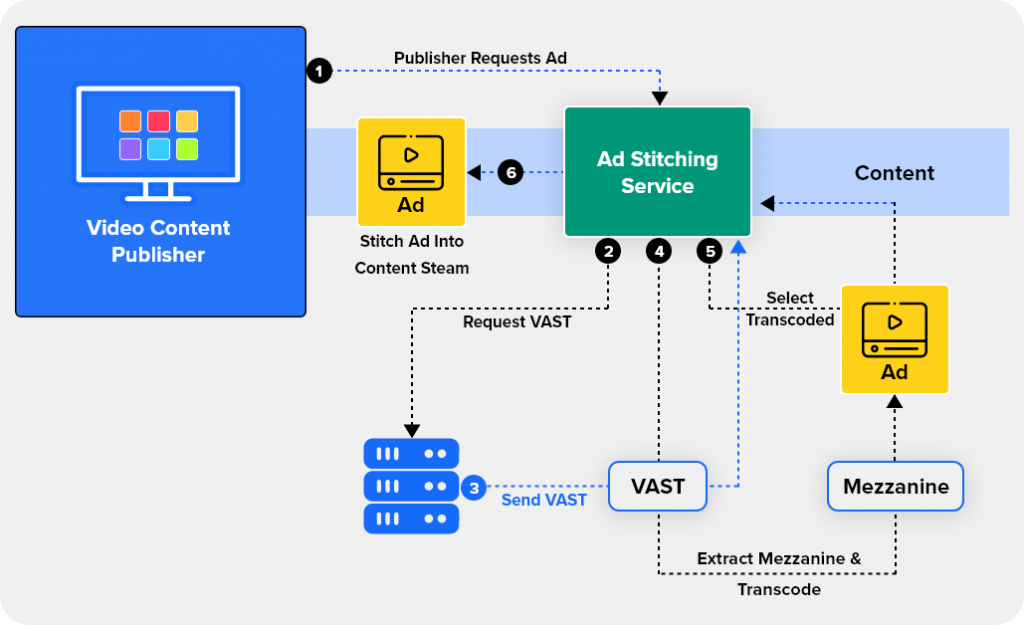
Manifest manipulation revolves around personalizing the video experience for each viewer when a stream is requested with video and audio segments. This process is accompanied by a manifest file that acts as a playlist, controlling the playback order.
Secondly, ad servers play a crucial role in storing and serving advertisements on online web pages. The communication with ad servers is facilitated through advertisement trafficking, providing real time analytics data into ad performance.
As we go deep into the insights related to video bitrate, it is essential to understand that bitrate represents the number of bits of video information transmitted per second, measured in kilobits per second or megabits per second.
Moreover, when compressing a video, the video compression software must be directed not to exceed a certain bitrate. This ensures efficient transmission and playback.
Furthermore, video resolution significantly influences what the user sees. Most video players automatically adjust themselves based on the viewing window or device’s screen resolution.
All these processes occur within the server-side ad insertion architecture before presenting a manifest to clients. SSAI, also known as dynamic ad insertion or ad stitching, seamlessly integrates the ad media into the video stream, eliminating the need for server calls to receive ads.
What Is The Differences Between CSAI and SSAI?
Generally speaking, SSAI is said to be slightly higher in terms of cost compared to CSAI, despite yielding effective results in ad impressions.
In the case of integrating client-side server ads, they aren’t always available to play due to ad blockers. This typifies the errors that occur on the client side, such as timeouts during the loading of an ad or errors in VPAID ads, etc.
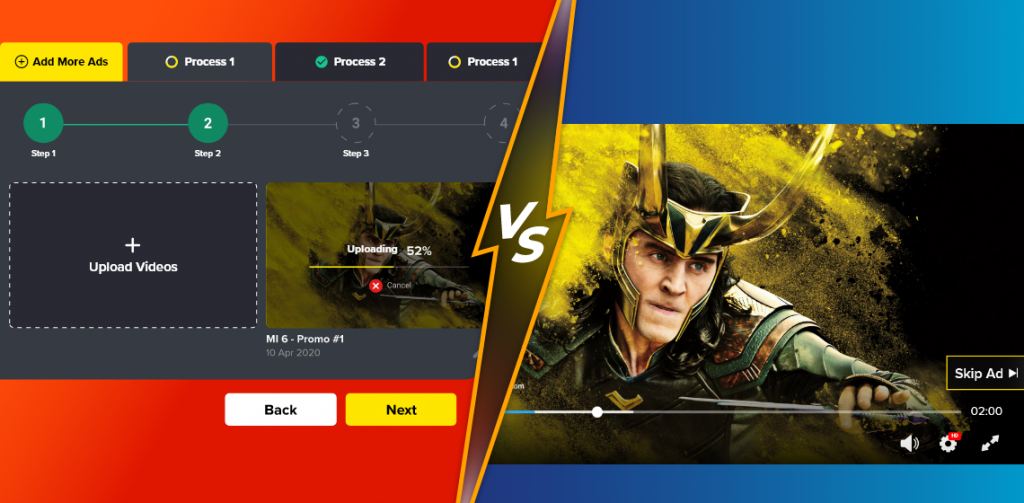
That’s the reason why understanding the advantages and drawbacks of Server-Side Ad Insertion (SSAI) and Client-Side Ad Insertion (CSAI) is pretty much important for publishers and advertisers. With this thing clear, let’s explore the pros and cons of each in this part.
Server-Side Ad Insertion vs. Client-Side Ad Insertion: Pros & Cons
| Pros of CSAI | Cons of CSAI |
| Publishers & Advertisers can create rich experiences with surveys, click-throughs, overlays, via a transitional ad-serving stack. | In CSAI, ad stitching is downstream by the player, leading to frame drops in the video and impacting the overall viewing experience. |
| Setting up detailed tracking in CSAI is easy, enabling the accumulation of a substantial amount of data for ad-tracking services. | In CSAI, the player must request an ad from the server, introducing latency and potentially disrupting the smooth flow of content. |
| CSAI technology facilitates the delivery of highly personalized ads, enhancing the overall engagement with the audience. | Disorganization in the ad server can result in incorrect bitstream requests, leading to buffering issues during video playback. |
| In the CSAI system, players seamlessly integrate ads with content, an integral process for a cohesive viewing experience. | CSAI lacks a perfect solution for handling live streaming, posing challenges in ensuring continuous and uninterrupted live streams. |
| Pros of SSAI | Cons of SSAI |
| SSAI delivers a broadcast-like experience by seamlessly stitching ads directly into the stream, enhancing user engagement. | Ad-blockers may obstruct SSAI advertising, blocking the origin of ad providers and preventing end-users from viewing the content. |
| Ad-insertion in the server is managed by SSAI, supporting devices where inserting code can be challenging, ensuring broader compatibility. | Spoofing in SSAI poses a risk as end devices send HTTP headers to ad servers, potentially allowing unauthorized setup and data manipulation. |
| SSAI effortlessly adapts to varying bandwidth conditions, delivering a smooth playback experience and improving streaming quality. | A lower degree of personalization is observed in SSAI, particularly if vendors aim to provide per-user custom manifests, resulting in a drain on resources. |
| In the SSAI system, ads are stitched upstream, reducing the need for players, as HTML5 is utilized for video playback. | Manifest caching issues arise in SSAI as server-side customizability makes per-user manifests challenging and inefficient for caching services. |
Why Should You Choose CSAI Or SSAI?
By now, you would have realized the fact that picking between CSAI (Client-Side Ad Insertion) and SSAI (Server-Side Ad Insertion) is a challenging undertaking. However, knowing the benefits and drawbacks of each of them can help you make an informed decision.
When it comes to CSAI, it is a client-side solution where the video player loads and inserts the ad into the video stream. It gives you greater control over the ad experience and can handle a wide range of ad formats, including interactive as well as personalized ads.
However, on the flip side, it can suffer from latency concerns and might not be suitable for websites or VOD platform that are able to generate huge traffic.
SSAI, on the other hand, stitches the ad into the video stream on the server-side prior to delivering the content to the viewer. This results in a hasslefree viewing experience, with no buffering or latency issues whatsoever.
SSAI is also more scalable and can handle large volumes of traffic, making it an ideal choice for a number of websites. When seeing its downside, it might not be as flexible as CSAI in terms of ad format support.
Now the million/billion dollar question? Which one should you choose? The answer actually lies on your individual requirements and needs. If you are looking for greater control over the ad experience, CSAI might be the right choice.
On the other side of the picture, if you are in search of a scalable solution for high-traffic websites, SSAI is the way to go. However, with the right solution in place, you can expect better ad performance, seamless viewing experiences, and increased revenue/profits.
Key Takeaways:
The ability to personalize viewing experiences stands out as a critical criterion that distinguishes itself in the era of online TV compared to traditional methods. As customer expectations steadily rise, whether for quality or value, showcasing content at a granular level becomes essential.
Meanwhile, content providers or content creators must make enough efforts to manage regional rights restrictions to safeguard the integrity of the content. This also holds true for the OTT monetization solution process with ad serving.
As discussed earlier, dynamic ads can be implemented in two ways: through CSAI and SSAI, each with its individual significance.
Ad servers and ad networks offer tracking, trafficking, and analytical solutions for both collaborators—advertisers and publishers. Several key parameters are considered in targeting ads, including:
- User Profile: This is based on factors such as location, operating system, browser, etc.
- Audience Behaviour: Understanding how the audience interacts with content plays a crucial role in effective ad targeting.
- Context of Content: The context in which the content is presented is a significant determinant for targeted ad delivery.
These considerations ensure a more refined and personalized approach to ad delivery, catering to the specific preferences and behaviors of the audience.
Frequently Asked Questions (FAQ):
Generally speaking, SSAI said to be a little high in terms of cost factor than CSAI, despite having effective results in ad impressions. In the case of integration of client’s-side server ads, they aren’t always been available to play due to ad blockers. This typifies the errors that happen on client side, time outs during loading an ad or error in VPAID ads, etc.
SSAI which is commonly known as server side ad insertion is a way of stitching an ad directly into the video that’s being streamed at the server but not the client/player. Basically, it is different from how CSAI work.
CSAI is the method used in delivering ads to devices like desktop, mobile, CTVs, gaming consoles where the video player requests the ad server to stream an advertisement when it reaches certain ad-markers in the stream or technically known in the manifest file (HLS/DASH).
Server side ad insertion is a combination of many individual functionalities. It starts with manifest manipulation, ad server communication, ad bitrate with resolution normalization
Manifest manipulation talks about personalizing the video experience for every viewer when a stream is requested with video & audio segments. It is then, accompanied by a manifest file which acts as a playlist & control the playback order.
Let’s take a glimpse through the working or processes of how CSAI (Client-Side Ad Insertion) works. In the beginning, the player downloads the file from the CDN before the video playback commences. For instance, in a pre-roll ad, the ad begins to play before the video sets in.
When the video player reaches an ad-marker, it makes an API call to the ad server, requesting for an ad in the playback. Typically, the ad insertion server, will respond with a VASY XML that contains data about the ad, the ad’s media as well as tracking information

